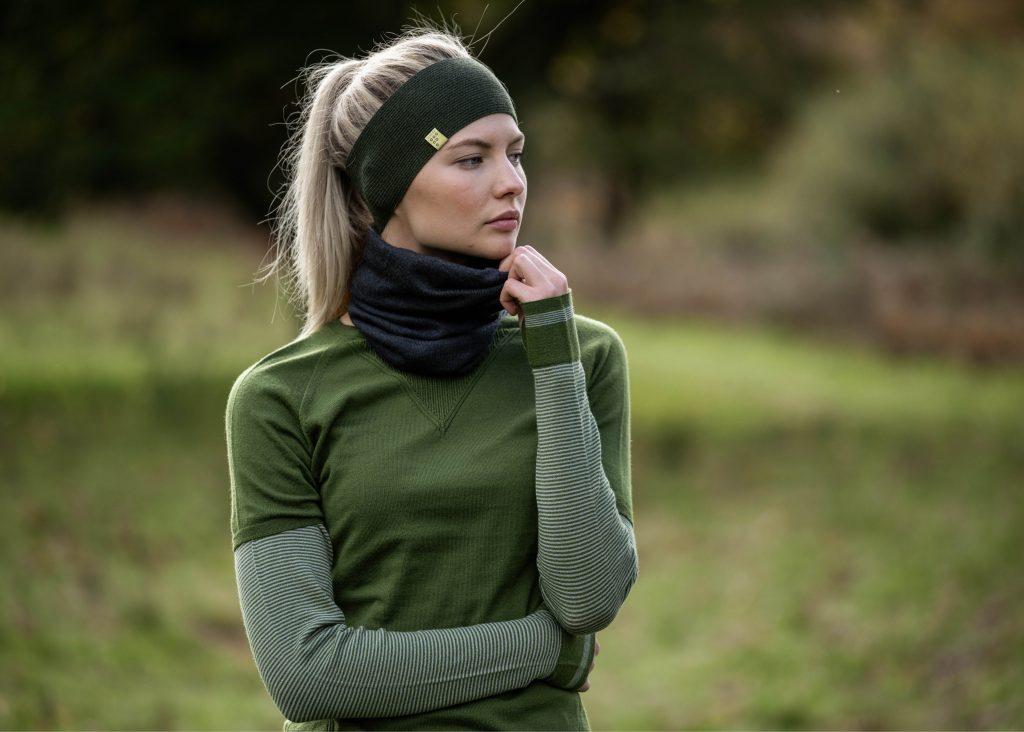
How to warm up after a swim: the wonders of merino
When it comes to warming up after a swim, material matters. Alex Feechan, founder of sustainable outdoor clothing brand Findra, gives us the low down on merino wool – an insulating fabric swimmers should consider wearing next to their skin after a winter dip
As we explored in our ‘How to layer up after a cold swim’ guide in the January edition of Outdoor Swimmer, one of the most efficient ways to warm up after a swim is to layer two or three insulating garments, rather than throwing on a big jumper. That’s because layers help to move moisture away from your skin and trap heat close to the body. But it’s not just the practice of layering that can keep you warm after a cold water swim, it pays to consider the material that you are putting next to your skin, too.
We spoke to Alex Feechan, founder of sustainable outdoor clothing brand FINDRA, to find out more about merino wool’s remarkable insulating properties and ask what kind of layering system works best for a cold water swimmer.
What are the benefits of wearing merino wool as opposed to other common clothing materials such as cotton or synthetic fabrics?
The hardy sheep that produce merino live in environments with extreme weather conditions, which has led their fleeces to evolve some incredible features. Merino wool fibres also have a natural temperature regulation and odour resistance that ensure the sheep’s survival.
The structural varieties of wool fibres are measured in microns. A micron is the diameter of one wool fibre and generally, the lower the micron count, the softer the wool. While lambswool typically has a micron count of around 25, Merino ranges between 15 and 20.
As well as a low micron count, merino fibres have a good crimp (coiled texture). This allows the fabric to be soft and springy and works to trap air, giving it insulating properties. Compared to heavy cotton, which is often grown with heavy agrochemicals in desert environments where water is scarce, merino is lighter, softer and more breathable.


Merino wool is also biodegradable; it can even be composted or recycled at the end of its life. It is a sustainable and renewable fibre, which doesn’t shed plastic microfibers in your washing machine like synthetic fabrics can. Plus merino’s natural odour-resistant and anti-bacterial qualities mean it is likely to use much less water over its lifecycle. All these factors help to make merino wool a more ethical and practical choice than synthetic alternatives and cotton.
What sort of layering system would you suggest for a cold-water swimmer?
The second you’ve dried off, you’re going to want to pull on a nice cosy base layer. The softer, the better. A high-wicking fabric like merino is a great idea, as it will help you deal with any residual moisture and clamminess. When you’ve been open water swimming, especially in places like Scotland where the water can stay cold even in summer, you need lots of layers to help you raise and regulate your core temperature as quickly as possible.
Accessories are handy for adding warmth as soon as you get out of the water, too. Woolly socks and a woolly bobble hat are great to get your extremities warm instantly and keep the heat in. They can also be pulled on quickly, while arm and neck warmers are great for adding extra heat once you’re dressed.
Can you tell us more about the different weights of merino garments and what works best in different conditions.
The weight of a merino wool garment is often measured in grams per square meter (gsm), indicating the density of the fabric, and they are designed to be layered. Here are our recommended uses by weight.
Ultralight (less than 150 gsm)
Best for: warm weather and high-intensity activities.
Uses: Running, hiking in hot climates, summer sports.
Characteristics: Lightweight and breathable, ideal for moisture management and quick drying. Great next to the skin layers.
Lightweight (150-200 gsm)
Best for: Spring and autumn seasons, moderate activity levels.
Uses: All activities from hiking, backpacking and cold water swimming to travelling in mild climates.
Characteristics: Balances breathability with a bit more insulation, suitable for a range of temperatures.
Midweight (200-250 gsm)
Best for: Cooler temperatures, versatile use.
Uses: Autumn and spring outdoor activities, as a mid-layer in colder conditions and can be layered up over the base layer.
Characteristics: Provides more insulation, suitable for a wide range of temperatures, and can serve as a standalone layer in milder conditions.
Heavyweight (250 gsm and above)
Best for: Cold weather, low-intensity activities.
Uses: Winter sports, camping in cold climates, as a base layer in freezing temperatures.
Characteristics: Offers substantial warmth and insulation, suitable for very cold conditions.

Is there anything else we should be considering when choosing a merino layer?
When choosing merino garments, make sure you purchase non-mulesed wool. The mulesing process can cause unnecessary suffering to sheep, and consumers increasingly advocate for products that align with humane farming practices. Mulesing is primarily aimed at preventing flystrike however this method involves removing strips of skin from the sheep’s buttock without anaesthesia, causing pain and distress to the animals.

Also, here at FINDRA, we make merino garments using 3D Seamless Knitting Technology, which enables garments to be knitted in one piece rather than assembled in several sections. Not only does the lack of seams create a stronger, more durable garment that won’t rub on your skin or wear down at important points but it also reduces waste in the production process, creating a zero waste garment.
What advice would you offer to outdoor swimmers wanting to warm up post-swim?
Layer up: Have a set of warm, dry layers ready for immediately after your swim. Dressing in layers helps trap heat close to your body and provides quick insulation.
Pack a hot beverage: Bring a thermos with a hot beverage like herbal tea, hot chocolate or warm soup. Consuming a warm drink can help raise your internal body temperature.
Stay active: Engage in light physical activity after your swim. Gentle movements, such as walking or light stretching, can help improve blood circulation and gradually raise your body temperature.
Change in a sheltered spot: Choose a sheltered area to change, especially if it’s windy. Wind can increase the rate of heat loss from your body, making it harder to warm up.
Have a rubdown: Give yourself a brisk rubdown or a quick self-massage to stimulate blood flow and generate warmth.
Bring a hot water bottle: Pack a hot water bottle in your bag. Placing it on your lap or against your torso can provide instant warmth during your post-swim recovery.
Don’t forget your woollen accessories: Wear natural woollen accessories whether merino or lambswool, woolen socks, gloves, neck warmers and headbands will all help you to retain heat in those vital areas. Wool has excellent insulating properties and can help keep you warm even when damp.
Eat something sweet: Always take a little sweet treat with you to enjoy with your hot drink post-swim, a piece of chocolate or a small cake will help restore your glycogen levels.
Read our ‘How to layer up after a cold swim’ guide. Discover more about FINDRA.








